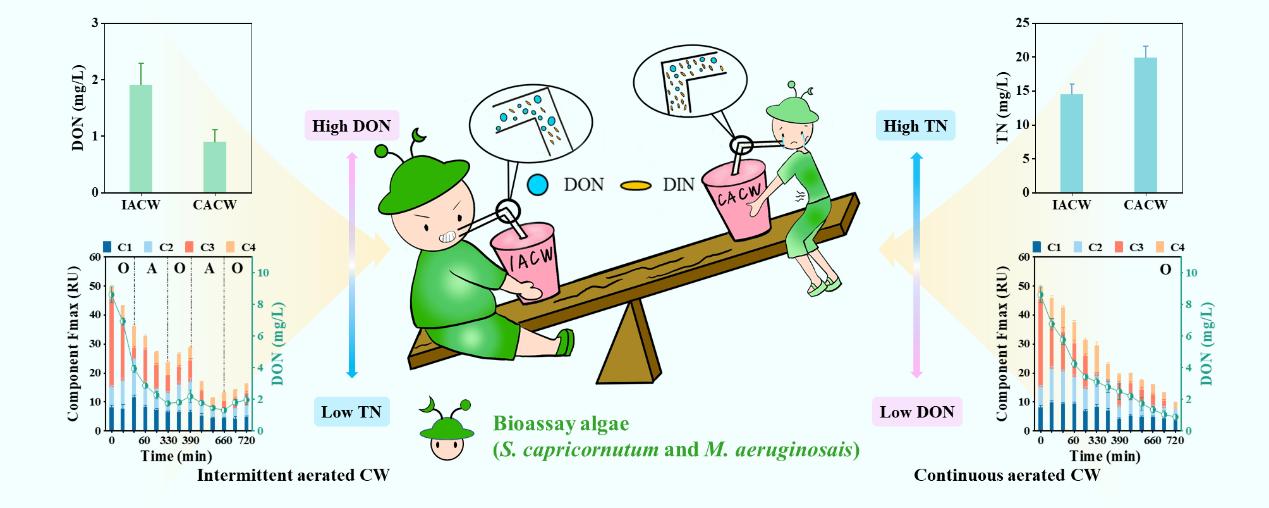南湖新闻网讯(通讯员 王晓宁)近日,我校水产学院设施渔业团队于Water Research在线发表题为“Formation of microorganism-derived dissolved organic nitrogen in intermittent aeration constructed wetland and its stimulating effect on phytoplankton production: Implications for nitrogen mitigation”的研究论文,该研究揭示了养殖尾水中溶解性有机氮在人工湿地中的转化规律及其环境效应。研究表明,间歇曝气虽能提升人工湿地总氮去除率,但却大幅增高其出水的溶解性有机氮浓度,可能导致受纳水体有害藻类增长,危害水环境健康。该研究对改善养殖尾水处理工艺及维护水生生态环境的健康具有重要意义。

不同曝气方式下氮素去除效果及藻类生物量示意图
过量氮素输入是造成受纳水体富营养化的关键,长期以来围绕如何消减污水中的无机氮开展了大量研究。本团队在前期的研究中发现,溶解性有机氮是水产养殖水体氮素的主要组成部分,可占养殖水体总氮的26.7~49.9%,但其生态效应却被忽视。因此,探究溶解性有机氮在尾水处理中的转化及其环境效应对于改善养殖尾水处理工艺及提升水环境健康具有重要意义。鉴于此,本研究以养殖尾水处理中应用广泛的人工湿地为研究对象,建立间歇曝气人工湿地与持续曝气人工湿地,探究曝气方式对溶解性有机氮的影响和潜在机制,并探讨溶解性有机氮在富营养化方面的潜在生态风险。研究发现,间歇曝气人工湿地虽可大大降低出水的总氮,但却可导致出水中溶解性有机氮和生物可利用性溶解性有机氮浓度大幅增高。进一步研究发现,间歇曝气人工湿地中缺氧到有氧环境的频繁转变刺激微生物源溶解性有机氮(色氨酸和简单芳香蛋白类物质)的释放是导致间歇曝气人工湿地出水溶解性有机氮增高的主要原因。更为重要的是,与持续曝气人工湿地的出水相比,虽然间歇曝气人工湿地虽可大幅削减总氮排放,但其出水培养的浮游植物生物量却较更高,并可能特异性刺激有害种类生物量的增长。总而言之,本研究结果表明仅依赖总氮去除可能无法有效减轻与氮相关的富营养化的问题,应加大对养殖尾水溶解性有机氮排放的管控力度。
水产学院博士研究生王晓宁为论文第一作者,水产学院何绪刚教授和侯杰副教授为论文共同通讯作者。研究受到国家重点研发项目、国家自然科学基金、中国农业研究系统的支持。
审核人:何绪刚、侯杰
【英文摘要】
To control eutrophication in aquatic ecosystems, enhancing nitrogen removal in the constructed wetland (CW) by upgrading conventional CW to aeration CW is commonplace. However, regulatory efforts have only focused on reducing dissolved inorganic nitrogen (DIN) discharge and disregarding dissolved organic nitrogen (DON). Here, we showed that one of the most common nitrogen removal enhancement technology, intermittent aeration, is prone to introduce large amounts of DON and bioavailable DON (ABDON) in the effluents, although it greatly decreases effluent total nitrogen (TN). Analysis of DON fluorescent components and molecular characteristics indicated that suddenly shifting the environment from anoxic condition to aerobic condition in the intermittent aeration CW (IACW) would stimulate microorganisms to release tryptophan and simple aromatic proteins-like substances, which does not occur in the limited continuous aeration CW (CACW). Consequently, the abundance of DON resembling lipids, proteins/amino sugars, and carbohydrates-like molecules in IACW were about 2.1 times higher than that in CACW. Bioassay results showed that Selenastrum capricornutum and Microcystis aeruginosa incubated with effluent from IACW both generate larger phytoplankton biomass than that with CACW effluent, even though IACW effluent contains less TN than its counterpart. Moreover, Microcystis aeruginosa can simultaneously utilize DON and DIN, while Selenastrum capricornutum seem to utilize the DON only when DIN was not available. This result implies that increasing DON discharge may also influence phytoplankton composition and stimulate harmful phytoplankton species. Overall, this study indicates that upgrading CW solely depending on DIN removal level cannot ensure a mitigation of nitrogen-related eutrophication, and more efforts should be paid to curb DON discharge.
论文连接:https://www.sciencedirect.com/science/article/pii/S0043135422015081